Stimulate Action with
the Gap Method
By Bill Flury
A stranger walks up to you and says, “Excuse me, your zipper is open”. Instinctively, you look for the exposed gap and rush to close it. Your reaction is intuitive and urgent.
Most people have a strong, inbred urge to try to close what they perceive as gaps. They feel compelled to try to fill the gap. This is the basis for what we call the “Gap Method for Stimulating Action”. You can take advantage of this reaction. If you have a job to be done, find a way to display it in such a way that people will perceive it as a gap that needs to be filled.
Just getting someone to see it as a gap may be enough to draw action. When applying this method in a business situation you can include an incentive to fill the gap by identifying someone to be responsible for filling it and making the gap and the assignment public. That will add peer pressure to the incentive for filling the gap.
Defining the Gap
To help people see and act on these gaps you have to arrange things so that the gap stands out. Once they see the gaps their interest in filling them will be stimulated and action should follow.
If you doubt the strength of this impulse you can try this example. At some place where a number of others will be passing by, write on a whiteboard or put up a sticky note showing the following:
Leave it there for a while with a pencil, marker or crayon nearby. Check it later to see what has happened since you put it there.
The usual result is that someone will have filled in a plus, minus, or multiplication sign and will have completed the operation. (You may have had that urge when you were posting it.) If you were to ask people about the note, few would say that it was just a 5 and a 3 and a line. Most would have seen it as an arithmetic problem and those who did would have felt an urge to complete the problem and may have done so.
What did you think when you saw the 5 and 3?
The Lure of the Gap
It is instructive and fun to recall some of the ways you people can be lured into doing something by the hidden urge to fill a gap. Who does the luring? The people who want you to do something. How do they do it? They set you up by creating a situation that allows (or compels you) to see the gap and conveys a sense of urgency in getting it filled. Here are some examples.
Collecting Quarters
A few years ago the government passed The Official United States Mint 50 State Quarters® Collector’s Map. This was custom-designed and produced for the Mint with the collector in mind. The blurb that came with it said:
This colorful and highly informative collector’s album has many features that make it a fun and educational tool for a child, adult or the whole family! A topographical state map of the United States with push-fit holders in which to collect all 50 State Quarters® from circulation. What fun for a child (or you!) to hunt for and collect each new quarter out of pocket change!
Wow! Fifty gaps to fill. Who could resist the opportunity to fill those push-fit holes? Everyone quickly became a collector and eagerly awaited the scheduled release of the new quarter for each state.
Then, in tiny print at the bottom of the chart is this little note expanding the gap:
Option to customize maps for collection of either Denver or Philadelphia mintmarks. In reality, there will be 100 quarters, not just 50! Unfolds to over 3 feet in length!
How many more gaps can they create to spur sales?
United Way
At one time or another everyone gets tapped to do some fundraising. The thermometer chart is the standard display used to help people see the gap that needs to be filled in order to meet the goal. There is a strong, visceral urge to get to the top. A Pie Chart also works, but is less effective. The way to fill the gap is less apparent.
Business Gaps
A manager trying to encourage groups to improve their performance will often present a chart like this and will ask the members of the group how they will improve their performance to bridge the gap. To make the gap more compelling, the manager can sub-divide the gap by tasks and show a detailed chart to let each team in the group see its own performance gap.
Task Completion Gaps
A Gantt chart showing task assignments, milestones, due dates, and task completions is a standard tool for showing gaps between actual and planned performance. Performance gaps can be specially highlighted by maintaining a “Today” line. Tasks planned to be done by “Today” that are to the left of “The Today Line” and are not shown to be done are late. Those are performance gaps that need to be urgently addressed.
Brainstorming Gaps
A good facilitator working with groups to help them define their business goals will not to start with a blank whiteboard. That’s too vague to be perceived as a gap. The expert’s approach is to get the group to agree on how many goals to set and then put up a number list of blank lines. Now the gaps are more demanding. And, when all but the last two numbered lines filled in, the final gap is really demanding.
The Gap method can be a powerful tool. When people can see the gap they will get busy and do what is needed to fill it. The key is being able to present the gap in a way that makes it easy for the viewer to see the opportunity to act.
Don’t forget one of the greatest examples, in front of a church a sign that is intended to encourage attendance – CH__CH. What’s missing? (UR)
the Gap Method


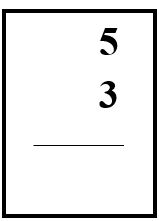
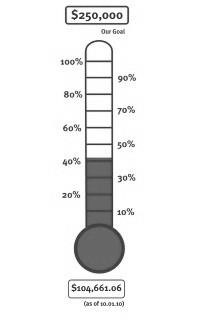
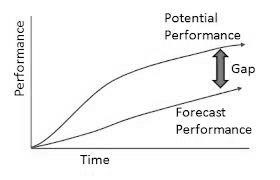
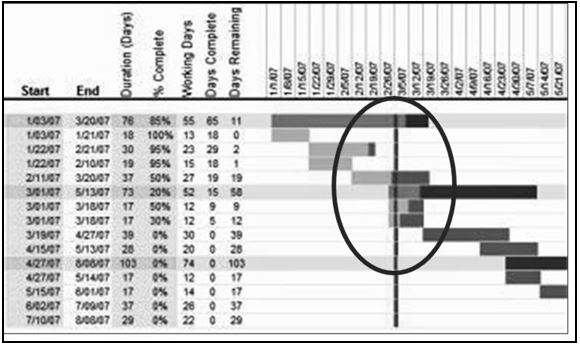
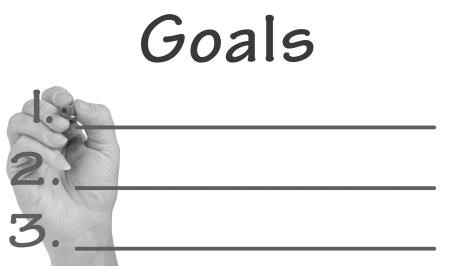




Bill, you are very creative and prolific. I enjoyed the life examples and the business examples.
I have bought a pistol and I use it at a firing range. I have targets which I date and save to see how I m progressing. Let’s just say that there is a big GAP in my marksmanship skills.
Am off to read your 2 other blogs……Best to you…Bob Pikul
Glad you enjoyed it. Thanks for the comment.
Now you can work on closing the gap between where your shots hit and the center of the target.